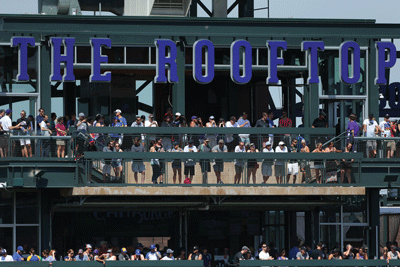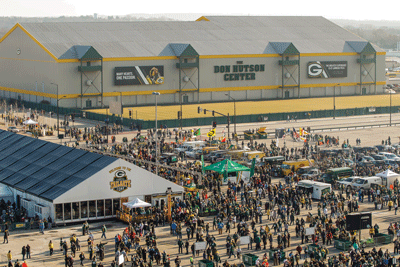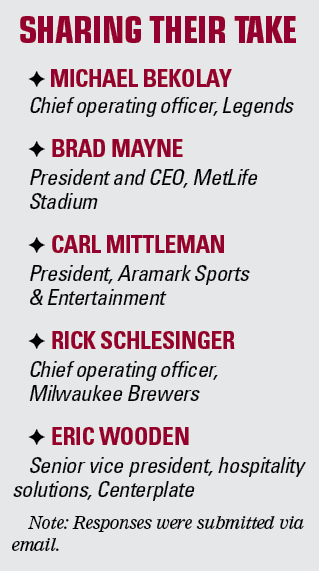What are the top two trends you’re watching in sports hospitality?
Carl Mittleman, Aramark: With millennials making up a large share of our fan base, they are looking for more
social-oriented offerings and destinations to supplement the action on the field. We’re working with clients to create standing-room-only bars, communal spaces and small-plate menus. For example, at PNC Park, the Pirates added terraces to Rivertowne Brewing Hall of Fame Club to provide fans direct access to the restaurant and their seats.
They also created an open-air lounge beyond the outfield wall with bar stools and sofas to accommodate large groups.
Technology adoption continues to play an important role in the game-day hospitality experience. We have passed the infrastructure and installation barriers, and are now focusing on adoption and application within venues.
Rick Schlesinger, Brewers: Our corporate clients want special insights into our business and the team. They are looking for access to our baseball operations executives and ownership for behind-the-scenes insights. The other trend we are seeing is corporate clients looking for activities that can be accessed by their employees or family. It’s not always about hosting the CEO of the client. Often, the CEO will want his/her front-line employees to enjoy the experiences.
Brad Mayne, MetLife Stadium: 1. We are constantly reviewing technology trends on multiple levels. The use of smart devices by our fans during events has grown exponentially. The in-stadium game presentation needs to be better than the in-home experience. Safety and security is not only important to our guests but a priority for the teams and venue. Data mining is key to our ability to deliver what our guests are seeking, as well as making purchase transactions convenient.
2. Fantasy sports.
 |
Social areas such as The Rooftop at Coors Field are a must for teams wanting to attract more millennials to their games.
Photo by: Getty Images |
Michael Bekolay, Legends: The first trend is all about being organic and sustainable. … This includes the providence of the base ingredients of the food we are sourcing and ultimately serving our guests. As a hospitality company, we are moving more and more to hormone-free and grass-fed proteins as well as cage-free eggs. At AT&T Stadium, we have a partnership with Paul Quinn College (which transformed an abandoned football field into an organic garden) and harvest 18,000 pounds of produce each season. In Sacramento, where we will operate the hospitality program at the new Golden 1 Center in 2016, we have committed to a trendsetting farm-to-fork program that includes us sourcing 90 percent of food and beverages locally within 150 miles.
Partnerships with local restaurateurs, chefs and breweries is certainly another trend that has continued to gain traction. We continue to see and hear from our guests about providing popular brands that they have an affinity and connection to.
Eric Wooden, Centerplate: Since my job is to really bring together the design and brand strategy with the menu development and delivery, the two trends that I’m watching most closely are: the creation of discrete destination areas that generate a targeted experience for a particular fan demographic; and overall, the trend of elevating the quality of menus with thoughtful procurement and premium ingredients, all of which requires a thoughtful approach to the design, infrastructure and service model.
What do you see as the future of tailgate-style and other “pop-up” temporary hospitality options being offered outside of sports venues?
Mittleman: Finding additional ways to program, activate and monetize outside the walls of a venue become increasingly important for sponsors, teams and team partners to connect with the guest. We’re working with several clients to create pop-up locations outside the confines of the venue to sell food, beverages and merchandise, which not only extends the team brand but further engages fans with the experience awaiting them once inside the stadium. For example, at a recent event at Soldier Field in Chicago, outside the stadium we erected pop-up adult beverage stations, brought in food trucks and arranged for hawkers to sell product.
Schlesinger: Our corporate clients prefer traditional tailgating experiences (tents, brats, beer and music) without some of the high-end/luxury offerings that may be available in other markets.
Bekolay: Operators have to look at the entire venue journey in totality. It is not just about the ticketed perimeter. It allows you to extend the guest’s time at the event, maximizing time with them, and gives them more exposure to the brand. The future of this programming is sure to include a more interactive approach that allows guests to become part of the process and not just a spectator. With the popularity of cooking shows and highly educated diners, having action stations where fans can ask questions, cheer on the chefs and even vote on their favorite dishes as they’re being served will be a fun way to engage fans on another level.
Wooden: Fans are looking for these offerings to be an informal event-within-an-event way to connect, and brands are looking for some out-of-the-box ways to relate to fans off the field. In both scenarios, it’s really the new center of the community, and it is becoming an important hospitality area as well as an entertainment experience unto itself. Centerplate operates The Faithful Mile at Levi’s Stadium, the Fan Plaza at the Superdome, and a pregame experience at Sports Authority Field at Mile High Stadium, and we will have new pregame options outside at Sun Life Stadium in Miami. We’re also about to launch a new fan zone at the Stadium of Light for Sunderland AFC in the U.K., and we’re consulting on massive fan plazas for Atlético de Madrid’s new stadium project and FC Barcelona’s Camp Nou. We’re building spaces that include hardscape elements as well as temporary fixtures that integrate food and beverage, sponsor activations, family activities, beer gardens … they’re basically mini street fairs and markets.
What elements/amenities are your best customers telling you they need to do greater business on game days?
Mittleman: We continue to focus on localizing and customizing our offerings to appeal to guests’ wide variety of tastes as well as taking steps to make each interaction with guests special.
Mayne: Our best customers want exclusive experiences such as access to players, locker-room-area corridors,
 |
Green Bay Packers fans head to the
Tailgate Zone outside Lambeau Field.
Photo by: Getty Images |
playing surface, press conferences, travel with the team, etc. Also fans not only want but demand quality, value and service.
Bekolay: It has certainly been a broad range of things. But it is all being centered on personalizing the experience. And this is manifesting itself in everything from high levels of customer service to diversity in menu options. This includes the ability to order their food with personal touches prior to an event to craving a signature item that can only be found at the venue and is associated with their favorite team.
Wooden: No. 1 is connectivity. Fans really need to be connected throughout the property through their devices, and as we’re taking hospitality outside of the traditional static concession stand, we increasingly need a reliable infrastructure to handle transactions, ordering and communications with guests in real time. Not far behind that is a one-of-a-kind experience. Unique items, hot concepts, menus and areas that get venues listed on the “best of” lists — our clients are trying to compete as entertainment destinations, and the hospitality is a brand extension that needs to be developed, cultivated and celebrated in a big way.
How important is ROI compared with the basic trend for upgrading the experience?
Mittleman: It’s all part of the same model and both are interconnected. We need to balance the economics and the experience. We are now using a triple bottom line to measure value in our venues — economics, experience and environment. All three need to work in unison to drive ROI.
Schlesinger: ROI is important for every element, but I think our corporate clients recognize that hospitality and the experiences we offer are not easily measurable in terms of ROI.
Mayne: Spending on the correct guest experiences will always generate a return on investment as our fans will become a promoter of our collective brands
and continued loyalty in attending our events.
Bekolay: While there is certainly a connection and we look at ROI, it’s the experience that dictates the road we travel down. We work closely with our partners and conduct a tremendous amount of fan focus groups and often hear that they are looking for an enhanced experience. We are in the business of making guests happy. As such, the need to reinvest in the experience in order to create the value that is in the ticket price becomes paramount. When done right, the ROI will occur, but it doesn’t lead the conversation; the idea and concept does.
Wooden: We see the ROI on tailgates and pop-ups as the same as in-stadium investment — creating a single, seamless experience regardless of the confines of the stadium, is the key. We need to beat the home theater environment, and when fans have gourmet kitchens, their own smokers and are even brewing beer, the hospitality component of a tailgate or pop-up needs to be brand appropriate and high quality. So we treat it the same as we would any other part of the stadium experience.






